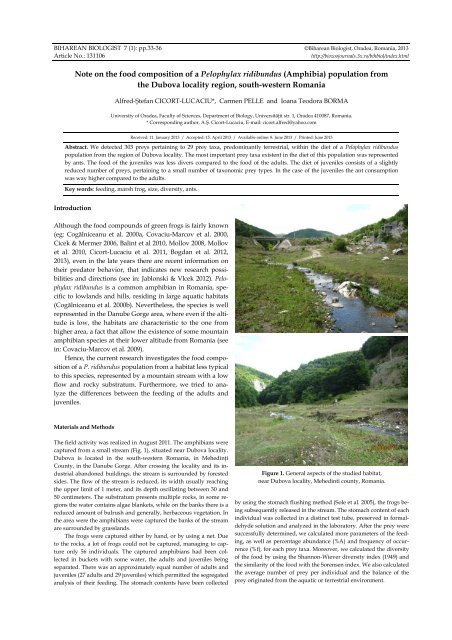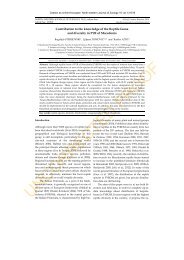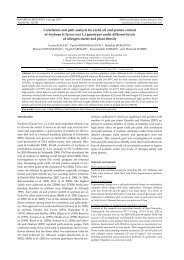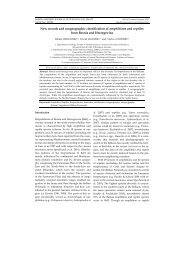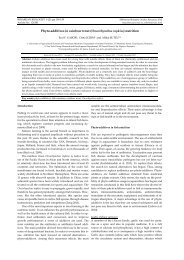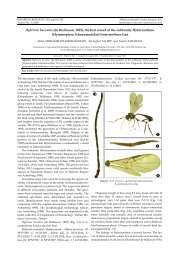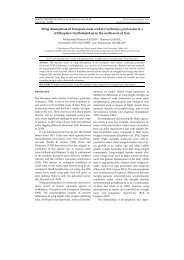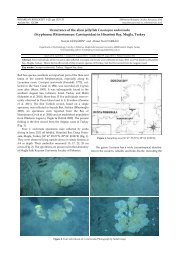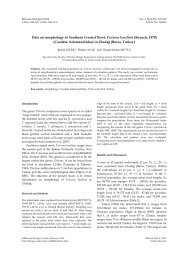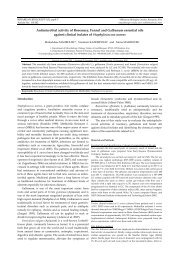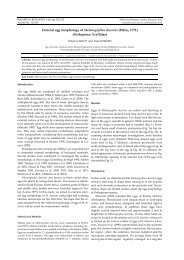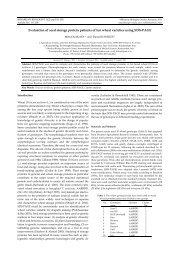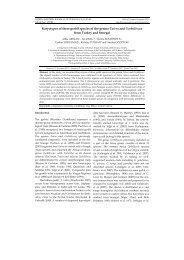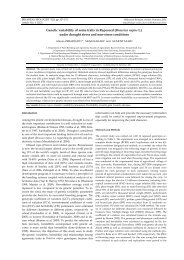Note on the food composition of a Pelophylax ridibundus (Amphibia ...
Note on the food composition of a Pelophylax ridibundus (Amphibia ...
Note on the food composition of a Pelophylax ridibundus (Amphibia ...
Create successful ePaper yourself
Turn your PDF publications into a flip-book with our unique Google optimized e-Paper software.
BIHAREAN BIOLOGIST 7 (1): pp.33-36 ©Biharean Biologist, Oradea, Romania, 2013<br />
Article No.: 131106 http://biozoojournals.3x.ro/bihbiol/index.html<br />
<str<strong>on</strong>g>Note</str<strong>on</strong>g> <strong>on</strong> <strong>the</strong> <strong>food</strong> compositi<strong>on</strong> <strong>of</strong> a <strong>Pelophylax</strong> <strong>ridibundus</strong> (<strong>Amphibia</strong>) populati<strong>on</strong> from<br />
<strong>the</strong> Dubova locality regi<strong>on</strong>, south-western Romania<br />
Alfred-Ştefan CICORT-LUCACIU*, Carmen PELLE and Ioana Teodora BORMA<br />
University <strong>of</strong> Oradea, Faculty <strong>of</strong> Sciences, Department <strong>of</strong> Biology, Universităţii str. 1, Oradea 410087, Romania.<br />
* Corresp<strong>on</strong>ding author, A.Ş. Cicort-Lucaciu, E-mail: cicort.alfred@yahoo.com<br />
Received: 11. January 2013 / Accepted: 15. April 2013 / Available <strong>on</strong>line: 8. June 2013 / Printed: June 2013<br />
Abstract. We detected 303 preys pertaining to 29 prey taxa, predominantly terrestrial, within <strong>the</strong> diet <strong>of</strong> a <strong>Pelophylax</strong> <strong>ridibundus</strong><br />
populati<strong>on</strong> from <strong>the</strong> regi<strong>on</strong> <strong>of</strong> Dubova locality. The most important prey taxa existent in <strong>the</strong> diet <strong>of</strong> this populati<strong>on</strong> was represented<br />
by ants. The <strong>food</strong> <strong>of</strong> <strong>the</strong> juveniles was less divers compared to <strong>the</strong> <strong>food</strong> <strong>of</strong> <strong>the</strong> adults. The diet <strong>of</strong> juveniles c<strong>on</strong>sists <strong>of</strong> a slightly<br />
reduced number <strong>of</strong> preys, pertaining to a small number <strong>of</strong> tax<strong>on</strong>omic prey types. In <strong>the</strong> case <strong>of</strong> <strong>the</strong> juveniles <strong>the</strong> ant c<strong>on</strong>sumpti<strong>on</strong><br />
was way higher compared to <strong>the</strong> adults.<br />
Key words: feeding, marsh frog, size, diversity, ants.<br />
Introducti<strong>on</strong><br />
Although <strong>the</strong> <strong>food</strong> compounds <strong>of</strong> green frogs is fairly known<br />
(eg: Cogălniceanu et al. 2000a, Covaciu-Marcov et al. 2000,<br />
Cicek & Mermer 2006, Balint et al 2010, Mollov 2008, Mollov<br />
et al. 2010, Cicort-Lucaciu et al. 2011, Bogdan et al. 2012,<br />
2013), even in <strong>the</strong> late years <strong>the</strong>re are recent informati<strong>on</strong> <strong>on</strong><br />
<strong>the</strong>ir predator behavior, that indicates new research possibilities<br />
and directi<strong>on</strong>s (see in: Jabl<strong>on</strong>ski & Vlcek 2012). <strong>Pelophylax</strong><br />
<strong>ridibundus</strong> is a comm<strong>on</strong> amphibian in Romania, specific<br />
to lowlands and hills, residing in large aquatic habitats<br />
(Cogălniceanu et al. 2000b). Never<strong>the</strong>less, <strong>the</strong> species is well<br />
represented in <strong>the</strong> Danube Gorge area, where even if <strong>the</strong> altitude<br />
is low, <strong>the</strong> habitats are characteristic to <strong>the</strong> <strong>on</strong>e from<br />
higher area, a fact that allow <strong>the</strong> existence <strong>of</strong> some mountain<br />
amphibian species at <strong>the</strong>ir lower altitude from Romania (see<br />
in: Covaciu-Marcov et al. 2009).<br />
Hence, <strong>the</strong> current research investigates <strong>the</strong> <strong>food</strong> compositi<strong>on</strong><br />
<strong>of</strong> a P. <strong>ridibundus</strong> populati<strong>on</strong> from a habitat less typical<br />
to this species, represented by a mountain stream with a low<br />
flow and rocky substratum. Fur<strong>the</strong>rmore, we tried to analyze<br />
<strong>the</strong> differences between <strong>the</strong> feeding <strong>of</strong> <strong>the</strong> adults and<br />
juveniles.<br />
Materials and Methods<br />
The field activity was realized in August 2011. The amphibians were<br />
captured from a small stream (Fig. 1), situated near Dubova locality.<br />
Dubova is located in <strong>the</strong> south-western Romania, in Mehedinţi<br />
County, in <strong>the</strong> Danube Gorge. After crossing <strong>the</strong> locality and its industrial<br />
aband<strong>on</strong>ed buildings, <strong>the</strong> stream is surrounded by forested<br />
sides. The flow <strong>of</strong> <strong>the</strong> stream is reduced, its width usually reaching<br />
<strong>the</strong> upper limit <strong>of</strong> 1 meter, and its depth oscillating between 30 and<br />
50 centimeters. The substratum presents multiple rocks, in some regi<strong>on</strong>s<br />
<strong>the</strong> water c<strong>on</strong>tains algae blankets, while <strong>on</strong> <strong>the</strong> banks <strong>the</strong>re is a<br />
reduced amount <strong>of</strong> bulrush and generally, herbaceous vegetati<strong>on</strong>. In<br />
<strong>the</strong> area were <strong>the</strong> amphibians were captured <strong>the</strong> banks <strong>of</strong> <strong>the</strong> stream<br />
are surrounded by grasslands.<br />
The frogs were captured ei<strong>the</strong>r by hand, or by using a net. Due<br />
to <strong>the</strong> rocks, a lot <strong>of</strong> frogs could not be captured, managing to capture<br />
<strong>on</strong>ly 56 individuals. The captured amphibians had been collected<br />
in buckets with some water, <strong>the</strong> adults and juveniles being<br />
separated. There was an approximately equal number <strong>of</strong> adults and<br />
juveniles (27 adults and 29 juveniles) which permitted <strong>the</strong> segregated<br />
analysis <strong>of</strong> <strong>the</strong>ir feeding. The stomach c<strong>on</strong>tents have been collected<br />
Figure 1. General aspects <strong>of</strong> <strong>the</strong> studied habitat,<br />
near Dubova locality, Mehedinti county, Romania.<br />
by using <strong>the</strong> stomach flushing method (Sole et al. 2005), <strong>the</strong> frogs being<br />
subsequently released in <strong>the</strong> stream. The stomach c<strong>on</strong>tent <strong>of</strong> each<br />
individual was collected in a distinct test tube, preserved in formaldehyde<br />
soluti<strong>on</strong> and analyzed in <strong>the</strong> laboratory. After <strong>the</strong> prey were<br />
successfully determined, we calculated more parameters <strong>of</strong> <strong>the</strong> feeding,<br />
as well as percentage abundance (%A) and frequency <strong>of</strong> occurrence<br />
(%f), for each prey taxa. Moreover, we calculated <strong>the</strong> diversity<br />
<strong>of</strong> <strong>the</strong> <strong>food</strong> by using <strong>the</strong> Shann<strong>on</strong>-Wiever diversity index (1949) and<br />
<strong>the</strong> similarity <strong>of</strong> <strong>the</strong> <strong>food</strong> with <strong>the</strong> Sorensen index. We also calculated<br />
<strong>the</strong> average number <strong>of</strong> prey per individual and <strong>the</strong> balance <strong>of</strong> <strong>the</strong><br />
prey originated from <strong>the</strong> aquatic or terrestrial envir<strong>on</strong>ment.
34<br />
Results<br />
Overall, <strong>the</strong> P. <strong>ridibundus</strong> populati<strong>on</strong> from Dubova c<strong>on</strong>sumed<br />
303 preys pertaining to 29 prey taxa (Tables 1 and 4),<br />
all 56 analyzed individuals presenting certain stomach c<strong>on</strong>tents.<br />
In additi<strong>on</strong> to <strong>the</strong> prey <strong>of</strong> animal origins, we found<br />
vegetal residue, shed skin remnants and various inorganic<br />
elements (Table 2). The majority <strong>of</strong> preys were terrestrial<br />
(96.69%) The average numbers <strong>of</strong> preys / individual was<br />
5.41, while <strong>the</strong> maximum number <strong>of</strong> prey / individual was<br />
16 (Table 3). The most important preys for this P. <strong>ridibundus</strong><br />
populati<strong>on</strong> were ants (Table 4). The ants were followed, according<br />
to percentage abundance, by <strong>the</strong> gastropods, and according<br />
to frequency by <strong>the</strong> gastropods and araneidae. The<br />
majority <strong>of</strong> <strong>the</strong> prey taxa identified in <strong>the</strong> stomach c<strong>on</strong>tents<br />
registered low value <strong>of</strong> percentage abundance and frequency<br />
<strong>of</strong> c<strong>on</strong>sumpti<strong>on</strong>.<br />
Table 1. The total number <strong>of</strong> prey items. The maximum and<br />
average number <strong>of</strong> prey items / individuals.<br />
Adults Juveniles Total<br />
No <strong>of</strong> prey items 175 128 303<br />
Maxim no. <strong>of</strong> preys<br />
/individual<br />
Average no. <strong>of</strong><br />
preys /individual<br />
16 12 16<br />
6.48 4.41 5.41<br />
Table 2. The frequency <strong>of</strong> occurrence <strong>of</strong> n<strong>on</strong>-animal<br />
stomach c<strong>on</strong>tents.<br />
Adults Juveniles Total<br />
% vegetal remains 74.07 48.28 60.71<br />
% shed skin 22.22 24.14 23.21<br />
% anorganic remains 14.81 13.79 14.29<br />
Table 3. The percentage abundance <strong>of</strong> aquatic and terrestrial preys.<br />
Adults Juveniles Total<br />
% terrestrial preys 95.42 98.43 96.69<br />
% aquatic preys 4.57 1.56 3.30<br />
There are several distincti<strong>on</strong>s between <strong>the</strong> diet <strong>of</strong> adults<br />
and juveniles, regarding <strong>the</strong> number <strong>of</strong> prey taxa, <strong>the</strong> number<br />
<strong>of</strong> c<strong>on</strong>sumed preys as well as <strong>the</strong> <strong>food</strong> diversity or vegetal<br />
c<strong>on</strong>sumpti<strong>on</strong>, etc.. Thus, in <strong>the</strong> case <strong>of</strong> juveniles <strong>the</strong> <strong>food</strong><br />
diversity was more reduced compared to <strong>the</strong> <strong>food</strong> <strong>of</strong> adults<br />
(juveniles H = 1.81 / adults H= 2.25) (Table 5). Likewise, <strong>the</strong><br />
adults c<strong>on</strong>sumed more prey taxa than <strong>the</strong> juveniles (24 compared<br />
to 20), and also more preys (6.48 preys / individual<br />
for adults up against <strong>on</strong>ly 4.41 preys / individual for juveniles).<br />
The differences between adults and juveniles can also<br />
be noticed in regards to <strong>the</strong> percentage abundance and frequency<br />
<strong>of</strong> c<strong>on</strong>sumpti<strong>on</strong> <strong>of</strong> <strong>the</strong> main tax<strong>on</strong>omic prey types<br />
(Table 4).<br />
Discussi<strong>on</strong>s<br />
The <strong>food</strong> <strong>of</strong> <strong>the</strong> P. <strong>ridibundus</strong> populati<strong>on</strong> from Dubova<br />
mainly c<strong>on</strong>sists <strong>of</strong> ants. Due to <strong>the</strong> predominance <strong>of</strong> this<br />
prey taxa, <strong>the</strong> diet <strong>of</strong> this populati<strong>on</strong> seems to be more simi-<br />
Cicort-Lucaciu, A.Ş. et al.<br />
lar to <strong>the</strong> <strong>food</strong> <strong>of</strong> Bombina variegata or Epidalea viridis, for<br />
whom ants are very important (e.g Groza et al. 2008, Kovacs<br />
et al. 2010, Ferenti et al. 2009, Covaciu-Marcov et al. 2010a,<br />
2011, 2012), than to <strong>the</strong> <strong>food</strong> <strong>of</strong> o<strong>the</strong>r c<strong>on</strong>specific populati<strong>on</strong>s<br />
(e.g. Cicek & Mermer 2006, Balint et al. 2010, Mollov 2008).<br />
However, as l<strong>on</strong>g as generally any trophic preferences have<br />
not been noticed in <strong>the</strong> case <strong>of</strong> P. <strong>ridibundus</strong> and <strong>the</strong> green<br />
frogs, dem<strong>on</strong>strating <strong>the</strong> existence <strong>of</strong> trophic opportunism<br />
(e.g. Cicek & Mermer 2006, Paunovic et al. 2010), <strong>the</strong> abundance<br />
<strong>of</strong> ants in <strong>the</strong> <strong>food</strong> <strong>of</strong> <strong>the</strong> P. <strong>ridibundus</strong> populati<strong>on</strong> from<br />
Dubova probably does not represent <strong>the</strong> result <strong>of</strong> <strong>the</strong>ir selectivity<br />
in relati<strong>on</strong> to ants, being <strong>on</strong>ly <strong>the</strong> result <strong>of</strong> ant abundance<br />
near <strong>the</strong> stream. Never<strong>the</strong>less, an increased percentage<br />
abundance and frequency <strong>of</strong> c<strong>on</strong>sumpti<strong>on</strong> <strong>of</strong> ants had<br />
been previously noticed in <strong>the</strong> <strong>food</strong> <strong>of</strong> a P. <strong>ridibundus</strong> populati<strong>on</strong><br />
from an artificial habitat, where <strong>the</strong> frogs c<strong>on</strong>sumed<br />
numerous terrestrial preys (Cicort-Lucaciu et al. 2011).<br />
The marsh frogs from Dubova were most likely forced to<br />
hunt in <strong>the</strong> terrestrial envir<strong>on</strong>ment due to <strong>the</strong> reduced size <strong>of</strong><br />
<strong>the</strong>ir habitat. This fact determined <strong>the</strong> categorical predominance<br />
<strong>of</strong> terrestrial preys in <strong>the</strong>ir <strong>food</strong>, because in specific<br />
circumstances <strong>the</strong> green frogs had c<strong>on</strong>sumed aquatic preys<br />
more frequently (Covaciu-Marcov et al. 2000, Mollov 2008,<br />
Sas et al. 2009). Thereby, <strong>the</strong> aquatic preys in Dubova represented<br />
<strong>on</strong>ly 3.30% <strong>of</strong> <strong>the</strong> total number <strong>of</strong> c<strong>on</strong>sumed preys<br />
(Table 3). The amount <strong>of</strong> aquatic preys is reduced regarding<br />
both <strong>the</strong> number <strong>of</strong> prey taxa, as well as <strong>the</strong> number <strong>of</strong> preys<br />
from those taxa. A large part <strong>of</strong> <strong>the</strong> small amount <strong>of</strong> aquatic<br />
preys was represented by larvae or adults <strong>of</strong> <strong>the</strong> own species,<br />
as well as in o<strong>the</strong>r cases (e.g. Cogălniceanu et al. 2000a,<br />
Mollov 2008).<br />
Unlike <strong>the</strong> adults, <strong>the</strong> P. <strong>ridibundus</strong> juveniles display a<br />
less various and intense feeding. Thus, <strong>the</strong>y c<strong>on</strong>sumed a<br />
slightly reduced number <strong>of</strong> preys, from a slightly reduced<br />
number <strong>of</strong> prey taxa. The absence <strong>of</strong> certain prey taxa from<br />
<strong>the</strong> <strong>food</strong> <strong>of</strong> juveniles had been presumably determined by<br />
<strong>the</strong> great size <strong>of</strong> that preys that could not be swallowed by<br />
<strong>the</strong> juveniles. Hereby, <strong>the</strong> Diplopoda or <strong>the</strong> Orthoptera<br />
sometimes have <strong>the</strong> sizes <strong>of</strong> <strong>the</strong> P. <strong>ridibundus</strong> juveniles. The<br />
larvae and especially o<strong>the</strong>r specimens <strong>of</strong> P. <strong>ridibundus</strong> are not<br />
included in <strong>the</strong> diet <strong>of</strong> <strong>the</strong> juveniles, due to <strong>the</strong> same reas<strong>on</strong>s.<br />
The differences between <strong>the</strong> diet <strong>of</strong> <strong>the</strong> adults and <strong>the</strong> diet <strong>of</strong><br />
<strong>the</strong> juveniles have been explained in <strong>the</strong> case <strong>of</strong> o<strong>the</strong>r amphibian<br />
species as well through <strong>the</strong>ir different sizes (eg: Cogălniceanu<br />
et al. 2000a, Ferenti & Covaciu-Marcov 2011, Polymeni<br />
et al. 2011). Meanwhile, <strong>the</strong> size differences determined<br />
<strong>the</strong> existence <strong>of</strong> important distincti<strong>on</strong>s in <strong>the</strong> <strong>food</strong><br />
compositi<strong>on</strong> or certain species <strong>of</strong> amphibians in <strong>the</strong> same<br />
habitat (eg: Cogălniceanu et al. 2000a, Arroyo et al. 2008, Covaciu-Marcov<br />
et al. 2012b).<br />
Yet, <strong>the</strong> absence <strong>of</strong> some prey taxa from <strong>the</strong> stomachs <strong>of</strong><br />
<strong>the</strong> juveniles cannot be explained through <strong>the</strong>ir sizes in all <strong>of</strong><br />
<strong>the</strong> circumstances. Thus, for example, <strong>the</strong> snout beetles reach<br />
sizes that can allow <strong>the</strong>ir c<strong>on</strong>sumpti<strong>on</strong> by P. <strong>ridibundus</strong> juveniles;<br />
however this kind <strong>of</strong> prey is not present in <strong>the</strong> diet <strong>of</strong><br />
juveniles. It is also possible that <strong>the</strong> adults can travel <strong>on</strong> larger<br />
distance than <strong>the</strong> juveniles, dislodging to a greater distance<br />
from <strong>the</strong>ir aquatic habitat. Therefore, <strong>the</strong> increased<br />
mobility <strong>of</strong> <strong>the</strong> adults could explain <strong>the</strong>ir exclusive Orthoptera<br />
c<strong>on</strong>sumpti<strong>on</strong> as well. In regards to o<strong>the</strong>r species <strong>of</strong> amphibians,<br />
Orthopteras have been c<strong>on</strong>sumed more <strong>of</strong>ten by
Food compositi<strong>on</strong> <strong>of</strong> a <strong>Pelophylax</strong> <strong>ridibundus</strong> populati<strong>on</strong><br />
Table 4. The percentage abundance (A%) and <strong>the</strong> frequency <strong>of</strong> occurrence (f%)<br />
<strong>of</strong> <strong>the</strong> c<strong>on</strong>sumed preys. L.- larvae, aq- aquatic.<br />
Adults Juveniles Total<br />
A% f% A% f% A% f%<br />
Nematomorpha (aq.) 1.14 7.41 0.00 0.00 0.66 3.57<br />
Annelida – Oligochaeta 0.57 3.70 0.78 3.45 0.66 3.57<br />
Gastropoda undet. 24.00 55.56 8.59 27.59 17.49 41.07<br />
Arachnida – Araneae 8.00 44.44 9.38 37.93 8.58 41.07<br />
Arachnida – Acaria 0.00 0.00 2.34 10.34 0.99 5.36<br />
Diplopoda 0.57 3.70 0.00 0.00 0.33 1.79<br />
Orthoptera 10.86 55.56 0.00 0.00 6.27 26.79<br />
Od<strong>on</strong>ata (l., aq.) 1.71 7.41 0.78 3.45 1.32 5.36<br />
Od<strong>on</strong>ata 0.00 0.00 0.78 3.45 0.33 1.79<br />
Homoptera – Cicadinea 2.86 14.81 0.78 3.45 1.98 8.93<br />
Heteroptera 7.43 40.74 10.16 31.03 8.58 35.71<br />
Lepidoptera (l.) 1.14 7.41 0.78 3.45 0.99 5.36<br />
Lepidoptera 1.71 11.11 0.00 0.00 0.99 5.36<br />
Coleoptera – Carabidae 4.57 25.93 1.56 6.90 3.30 16.07<br />
Coleoptera – Staphylinidae 0.00 0.00 0.78 3.45 0.33 1.79<br />
Coleoptera – Scarabaeidae 0.57 3.70 0.00 0.00 0.33 1.79<br />
Coleoptera – Elateridae 1.14 3.70 1.56 6.90 1.32 5.36<br />
Coleoptera – Curculi<strong>on</strong>idae 2.86 14.81 0.00 0.00 1.65 7.14<br />
Coleoptera undet. (l.) 0.57 3.70 1.56 6.90 0.99 5.36<br />
Coleoptera undet. 3.43 7.41 6.25 20.69 4.62 14.29<br />
Diptera – Nematocera 0.57 3.70 0.00 0.00 0.33 1.79<br />
Diptera – Brachycera (l., aq.) 0.00 0.00 0.78 3.45 0.33 1.79<br />
Diptera – Brachycera (l.) 0.00 0.00 0.78 3.45 0.33 1.79<br />
Diptera – Brachycera 0.57 3.70 3.13 10.34 1.65 7.14<br />
Hymenoptera – Formicidae 20.00 51.85 46.09 58.62 31.02 55.36<br />
Hymenoptera – Apidae 1.71 7.41 0.78 3.45 1.32 5.36<br />
Hymenoptera undet. 2.29 14.81 2.34 3.45 2.31 8.93<br />
Anura (l., aq.) 1.14 3.70 0.00 0.00 0.66 1.79<br />
Anura – P. <strong>ridibundus</strong> (aq.) 0.57 3.70 0.00 0.00 0.33 1.79<br />
Table 5. The <strong>food</strong> diversity and similarity.<br />
Adults Juveniles Total<br />
Shann<strong>on</strong> index 2.25 ± 0.14 1.81 ± 0.16 2.25 ± 0.12<br />
Sorensen index<br />
(mean value)<br />
0.31 0.23 0.25<br />
adults (e.g. Ferenti & Covaciu-Marcov et al. 2011). In this<br />
manner, <strong>the</strong> adults that are more voluminous and movable<br />
are capable <strong>of</strong> capturing Orthopteras fairly easy compared to<br />
<strong>the</strong> juveniles. There are probably certain tax<strong>on</strong>omic prey<br />
types whose exclusive presence in <strong>the</strong> diet <strong>of</strong> <strong>on</strong>e <strong>of</strong> <strong>the</strong> size<br />
categories is purely coincidental.<br />
Probably, <strong>the</strong> most obvious discrepancy between <strong>the</strong> diet<br />
<strong>of</strong> <strong>the</strong> adults and <strong>the</strong> diet <strong>of</strong> <strong>the</strong> juveniles lays in <strong>the</strong> ant c<strong>on</strong>sumpti<strong>on</strong>.<br />
Hence, in <strong>the</strong> case <strong>of</strong> juveniles, ants present more<br />
than a double percentage abundance compared to <strong>the</strong> adults,<br />
whe<strong>the</strong>r <strong>the</strong> ant c<strong>on</strong>sumpti<strong>on</strong> frequency is alike between<br />
adults and juveniles. Perhaps this discrepancy between percentage<br />
abundance and frequency <strong>of</strong> occurrence points to<br />
<strong>the</strong> fact that ants have been uniformly distributed and widespread<br />
in <strong>the</strong> habitat, being accessible for adults as well as<br />
juveniles. However, <strong>on</strong>ly <strong>the</strong> juveniles c<strong>on</strong>sumed high quantities<br />
<strong>of</strong> ants. Again, this fact is likely a result <strong>of</strong> <strong>the</strong> size differences<br />
between adults and juveniles. The adults that could<br />
reach big-sized preys were no l<strong>on</strong>ger bound <strong>on</strong>ly to <strong>the</strong> ants.<br />
Despite <strong>the</strong> ant c<strong>on</strong>sumpti<strong>on</strong>, <strong>the</strong> feeding <strong>of</strong> <strong>the</strong> juveniles<br />
was not more intense than <strong>the</strong> feeding <strong>of</strong> <strong>the</strong> adults. In this<br />
manner, <strong>the</strong> <strong>of</strong>fspring did not counterbalance <strong>the</strong> reduced attainability<br />
towards <strong>the</strong> large prey through <strong>the</strong> increased<br />
number <strong>of</strong> small prey c<strong>on</strong>sumed. Reduced diversity as well<br />
as <strong>the</strong> reduced number <strong>of</strong> c<strong>on</strong>sumed prey was noticed in <strong>the</strong><br />
case <strong>of</strong> <strong>the</strong> juveniles <strong>of</strong> o<strong>the</strong>r amphibian species compared to<br />
<strong>the</strong> adults (Kovacs et al. 2010b, Polymeni et al. 2011). Perhaps,<br />
as a c<strong>on</strong>sequence <strong>of</strong> <strong>the</strong> intense feeding process too,<br />
<strong>the</strong> adults c<strong>on</strong>sume <strong>the</strong> vegetal remnants more <strong>of</strong>ten than<br />
<strong>the</strong> juveniles, <strong>the</strong>se being usually swallowed accidentally<br />
with <strong>the</strong> targeted prey (e.g. Mollov 2008, Covaciu-Marcov et<br />
al. 2010a). Unlike <strong>the</strong> vegetal remnants, <strong>the</strong> differences between<br />
<strong>the</strong> shed skin and inorganic element c<strong>on</strong>sumpti<strong>on</strong> do<br />
not differ almost at all between adults and juveniles. Probably,<br />
<strong>the</strong>se elements display a homogenous dispersi<strong>on</strong> in <strong>the</strong><br />
hunting area <strong>of</strong> <strong>the</strong> amphibians.<br />
Acknowledgements. We want to thank to Severus-Daniel Covaciu-<br />
Marcov and Istvan Sas-Kovacs from <strong>the</strong> University <strong>of</strong> Oradea for<br />
<strong>the</strong>ir valuable help <strong>on</strong> <strong>the</strong> field and for <strong>the</strong> comments <strong>on</strong> <strong>the</strong> early<br />
versi<strong>on</strong> <strong>of</strong> <strong>the</strong> manuscript.<br />
35
36<br />
References<br />
Arroyo, S.B., Serrano-Cardozo, V.H., Ramirez-Pinilla, M.P. (2008): Diet,<br />
microhabitat and time <strong>of</strong> activity in a Pristimantis (Anura, Strabomantidae)<br />
assemblage. Phyllomedusa 7(2): 109-119.<br />
Balint, N., Indrei, C., Ianc, R., Ursut, A. (2010): On <strong>the</strong> diet <strong>of</strong> <strong>the</strong> Pelopylax<br />
<strong>ridibundus</strong> (Anura, Ranidae) in Ticleni, Romania. South Western Journal <strong>of</strong><br />
Horticulture, Biology and Envir<strong>on</strong>ment 1(1): 57-66.<br />
Bogdan, H.V., Covaciu-Marcov, S.D., Cupsa, D., Cicort-Lucaciu, A.S., Sas, I.<br />
(2012): Food compositi<strong>on</strong> <strong>of</strong> a <strong>Pelophylax</strong> <strong>ridibundus</strong> (<strong>Amphibia</strong>) populati<strong>on</strong><br />
from a <strong>the</strong>rmal habitat in Banat regi<strong>on</strong> (Southwestern Romania). Acta<br />
Zoologica Bulgarica 64(3): 253-262.<br />
Bogdan, H.V., Covaciu-Marcov, S.D., Gaceu, O., Cicort-Lcaciu, A.S., Ferenţi, S.,<br />
Sas-Kovács, I. (2013): How do we share <strong>food</strong>? Feeding <strong>of</strong> four amphibian<br />
species from an aquatic habitat in south–western Romania. Animal<br />
Biodiversity and C<strong>on</strong>servati<strong>on</strong> 36(1): 89-99.<br />
Çiçek, K., Mermer, A. (2006): Feeding Biology <strong>of</strong> <strong>the</strong> Marsh Frog, Rana ridibunda<br />
Pallas 1771, (Anura, Ranidae) in Turkey’s Lake District. North-Western<br />
Journal <strong>of</strong> Zoology 2(2): 57-72.<br />
Cicort-Lucaciu, A.Ş., Cupsa, D., Ilies, D., Ilies, A., Baias, S., Sas, I. (2011):<br />
Feeding <strong>of</strong> two amphibian specieis (Bombina variegata and <strong>Pelophylax</strong><br />
<strong>ridibundus</strong>) from artificial habitats from Padurea Craiului Mountains<br />
(Romania). North-Western Journal <strong>of</strong> Zoology 7 (2): 297-303.<br />
Cogălniceanu, D., Palmer, M,W., Ciubuc. C. (2001a): Feeding in Anuran<br />
comunities <strong>on</strong> islands in <strong>the</strong> Danube floodplain. <strong>Amphibia</strong>-Reptilia 22: 1-19.<br />
Cogălniceanu, D., Aioanei, F., Bogdan, M. (2000b): Amfibienii din România,<br />
Determinator. Ed. Ars Docendi, Bucharest. [in Romanian].<br />
Covaciu-Marcov, S.D., Cupşa, D., Ghira, I. (2000): Trophical spectrum <strong>of</strong> a Rana<br />
ridibunda ridibunda Pallas 1771 populati<strong>on</strong> from Cefa (Bihor county,<br />
România). Bacau, Studii şi Cercetări, Biologie 5: 107-115.<br />
Covaciu-Marcov, S.D., Cicort-Lucaciu, A.Ş., Gaceu, O., Sas, I., Ferenţi, S.,<br />
Bogdan, H.V. (2009): The herpet<strong>of</strong>auna <strong>of</strong> <strong>the</strong> south-western part <strong>of</strong><br />
Mehedinţi County, Romania. North Western Journal <strong>of</strong> Zoology 5(1): 142-<br />
164.<br />
Covaciu-Marcov, S.D., Cupşa, D., Ferenţi, S., David, A., Dimancea, N. (2010a):<br />
Human influence or natural differentiati<strong>on</strong> in <strong>food</strong> compositi<strong>on</strong> <strong>of</strong> four<br />
amphibian species from Histria Fortress, Romania? Acta Zoologica Bulgarica<br />
62(3): 307-313.<br />
Covaciu-Marcov, S.D., Cicort-Lucaciu, A.Ş., Mitrea, I., Sas, I., Căuş, A.V.,<br />
Cupşa, D. (2010b): Feeding <strong>of</strong> three syntopic newt species (Triturus cristatus,<br />
Mesotrit<strong>on</strong> alpestris and Lissotrit<strong>on</strong> vulgaris) from Western Romania. North-<br />
Western Journal <strong>of</strong> Zoology 6(1): 95-108.<br />
Covaciu-Marcov, S.D., Ferenţi, S., Citrea, L., Cupsa, D., C<strong>on</strong>dure, N. (2011):<br />
Food compositi<strong>on</strong> <strong>of</strong> three Bombina variegata populati<strong>on</strong>s from Valsan River<br />
Protected Natural Area (Romania). Biharean Biologist 5(1): 11-16.<br />
Covaciu-Marcov, S.D., Ferenti, S., Cicort-Lucaciu, A.S., Sas-Kovács, I. (2012):<br />
Terrestrial isopods in <strong>the</strong> diet <strong>of</strong> two amphibian species (Epidalea viridis and<br />
Pelobates syriacus) from Dobruja, Romania. Entomologica Romanica 17: 5-11.<br />
Ferenţi, S., Covaciu-Marcov, S.D. (2011): Comparative data <strong>on</strong> <strong>the</strong> trophic<br />
spectrum <strong>of</strong> syntopic Bombina variegata and Rana temporaria (<strong>Amphibia</strong>:<br />
Cicort-Lucaciu, A.Ş. et al.<br />
Anura) Populati<strong>on</strong>s from Iezer Mountains, Romania. Ecologia Balkanica<br />
3(1): 25-31.<br />
Ferenţi, S., Cupşa, D., Dimancea, N., Bogdan, H.V., Filim<strong>on</strong>, A. (2009): Data<br />
up<strong>on</strong> <strong>the</strong> feeding <strong>of</strong> two Epidalea viridis populati<strong>on</strong> from Dobroudja,<br />
Romania. Oltenia, Studii si Comunicari Stiintele Naturii 25: 193-198.<br />
Groza, M.I., Suciu. I.C., Ancău, M., Pali. I.N., Letai. V. (2008): Comparis<strong>on</strong><br />
between males and females feeding habits from three populati<strong>on</strong>s <strong>of</strong><br />
Bombina variegata from Vadu Crişului, Pădurea Craiului Mountains,<br />
Romania. Biharean Biologist 2: 50-57.<br />
Jabl<strong>on</strong>ski, D., Vlček, P. (2012): A record <strong>of</strong> <strong>Pelophylax</strong> esculentus attack <strong>on</strong><br />
Bombina variegata. Herpetology <str<strong>on</strong>g>Note</str<strong>on</strong>g>s 5: 503-505.<br />
Kovács, I., Covaciu-Marcov, S.D., Doble, C., Blaga-Lungulescu, R.M., Toth, G.<br />
(2010a): The comparative analysis <strong>of</strong> <strong>the</strong> feeding <strong>of</strong> Bombina variegata<br />
populati<strong>on</strong>s from thr Almăş-Agrij Depressi<strong>on</strong>, Sălaj County, Romania.<br />
South-Western Journal <strong>of</strong> Horticulture, Biology and Envir<strong>on</strong>ment 1(2): 89-<br />
120.<br />
Kovács, I., David, A., Ferenţi, S., Dimancea, N. (2010b): The <strong>food</strong> compositi<strong>on</strong> <strong>of</strong><br />
two brown frog populati<strong>on</strong>s (Rana dalmatina and Rana temporaria) from Sălaj<br />
County, Romania. Biharean Biologist 4(1): 7-14.<br />
Mollov, I.A. (2008): Sex based differences in <strong>the</strong> trophic niche <strong>of</strong> <strong>Pelophylax</strong><br />
<strong>ridibundus</strong> (Pallas, 1771) (<strong>Amphibia</strong>: Anura) from Bulgaria. Acta Zoologica<br />
Bulgarica 60(3): 277-284.<br />
Mollov, I.A., Boyadzhiev, P., D<strong>on</strong>ev, A. (2010): Trophic role <strong>of</strong> <strong>the</strong> marsh frog<br />
<strong>Pelophylax</strong> <strong>ridibundus</strong> (Pallas, 1771) (<strong>Amphibia</strong>: Anura) in <strong>the</strong> aquatic<br />
ecosystems. Bulgarian Journal <strong>of</strong> Agricultural Science 16(3): 298-306.<br />
Paunović, A., Bjelić-Čabrilo, O., Šimic, S. (2010): The diet <strong>of</strong> water frogs<br />
(<strong>Pelophylax</strong> esculentus "Complex") from <strong>the</strong> Petrovaradinski Rit Marsh<br />
(Serbia). Archives <strong>of</strong> Biological Sciences 62(3): 797-804.<br />
Polymeni, R.M., Radea, C., Papanayotou, C. (2011): Diet Compositi<strong>on</strong> <strong>of</strong> <strong>the</strong><br />
Salamander Lyciasalamandra luschani basoglui <strong>on</strong> <strong>the</strong> Greek Island <strong>of</strong><br />
Kastellorizo in <strong>the</strong> Sou<strong>the</strong>ast Agean Sea. Asian Herpetological Research 2(3):<br />
155-160.<br />
Shann<strong>on</strong>, C.E., Wiener, W. (1949): The ma<strong>the</strong>matical <strong>the</strong>ory <strong>of</strong> communicati<strong>on</strong>.<br />
Univ. Illinois Press, Urbana.<br />
Solé, M., Beckmann, O., Pelz, B., Kwet, A., Engels, W. (2005): Stomach-flushing<br />
for diet analysis in anurans: an improved protocol evaluated in a case study<br />
in Araucaria forests, sou<strong>the</strong>rn Brazil. Studies <strong>on</strong> Neotropical Fauna and<br />
Envir<strong>on</strong>ment 40(1): 23-28.<br />
Sas, I., Covaciu-Marcov, S.D., Strugariu, A., David, A., Ilea, C. (2009): Food<br />
habit <strong>of</strong> Rana (Phelophylax) kl. esculenta females in a new recorded E-system<br />
populati<strong>on</strong> from a forested habitat in North-Western Romania. Turkish<br />
Journal <strong>of</strong> Zoology 33: 1-5.


